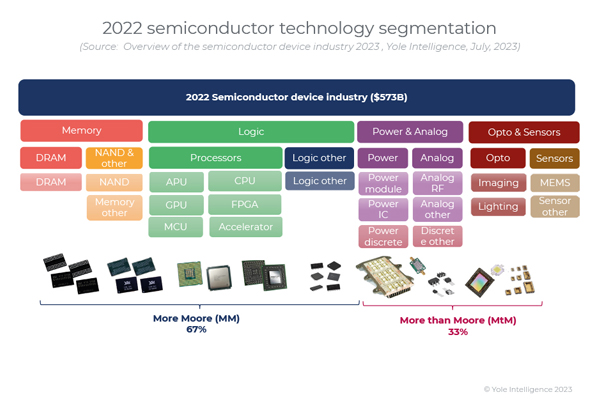Yole Intelligence, part of Yole Group, has released its "Overview of the Semiconductor Devices Industry 2023" report. According to the report, the trillion dollar semiconductor industry is poised for a new cycle of growth fueled by breakthroughs in artificial intelligence, quantum computing, 5G and specialized applications.
Market Growth and Global Demand Fuel the Semiconductor Device Industry
Semiconductor device revenue peaked in 2022 at $573B and is expected to retreat 7 percent to $534B in 2023. This industry plays a critical role in enabling technological advancements across various sectors, including Mobile & Consumer, Infrastructure, Automotive, Industrial and more. Over the past few decades, the industry has experienced a sustained 6.4 percent compound annual growth rate, driven by increasing demand for Mobile & Consumer electronics, the rise of internet applications such as social media, and the rapid digitalization of most industries.
Integrated circuits are becoming smaller, more powerful and capable of handling complex tasks, paving the way for new technology advancements such as artificial intelligence, machine learning and edge computing. This evolution presents both opportunities and challenges for companies in the industry, requiring them to invest massively in R&D and capital expenditure for new foundries to maintain significance in this fast-paced ecosystem.

Navigating the Global Supply Chains of the Semiconductor Industry
The semiconductor device industry relies heavily on global ecosystems, making supply chain resilience and risk mitigation crucial for sustained success. Recent disruptions and geopolitical tensions have highlighted the vulnerabilities of the semiconductor supply chain.
The semiconductor industry is geographically concentrated in a few places, primarily the U.S., Taiwan, Korea, Japan, Europe and mainland China. The dominance of U.S.-based semiconductor device companies is historical; in the last five years, they have maintained a 53 percent market share. If we combine all types of semiconductor company business models, i.e., adding the open foundries, OSAT, equipment and material companies, the market share of U.S. companies drops to 41 percent; and if only the added value is considered, then the U.S. share becomes 32 percent, and this number has been diminishing at a rate of 1 percentage point per year in the last five years.
U.S. semiconductor companies have developed the fabless business model, which helped maintain their dominance but created huge vulnerabilities toward Taiwan.
 Advancing Semiconductor Technologies are Shaping the Semiconductor Landscape
Advancing Semiconductor Technologies are Shaping the Semiconductor Landscape
The technology trend is no longer single-threaded. At the center of competition is the More Moore node race in the manufacturing process, currently 7, 5 and 3 nm, as well as future smaller nodes. These cutting-edge processes enable higher transistor density, improved performance and energy efficiency though they pose significant challenges in terms of development costs, yield rates and manufacturing complexity. The industry is, therefore, actively exploring innovative solutions through More than Moore approaches. NAND memory is headed full steam into 3D stacking, while advanced packaging has become vital for all leading players. Many innovations trends are driving the semiconductor industry; wide bandgap compound semiconductors, photonic integration, quantum computing, and neuromorphics will play their role in expanding the industry to serve a growing diversity of semiconductor device types.

